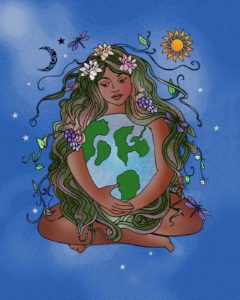New Mexico Interfaith Power & Light
Gaia Earth
June 7, 2019Diversity, Essence, and Communion
Sr. Joan Brown is a longtime friend and Franciscan, serving as Executive Director of New Mexico Interfaith Power and Light, a nonprofit that works for climate justice. She writes about three foundational principles needed for harmony and wholeness:
‘All of us who live, breathe, and walk upon this amazing, holy Mother Earth are called to understand the cosmic principles inherent in the interdependent energy dynamic that throbs through every element of life. Nothing exists without these three interdependent energies that emerged from the first flaring forth over 13.8 billion years ago: differentiation or diversity; subjectivity, interiority, or essence; and communion or community and interconnectedness. These energies offer vital lessons for the critical times in which we live, where diversity causes conflict, living is often at a superficial level, and individualism runs rampant. [1]
First, every one of us—every human being, every drop of water, every molecule, every bird, each grain of sand, and each mountain—is distinct or different. Each is a distinct manifestation of Divine Love energy. The universe thrives upon, and cannot exist without, diversity. The very differences that we shun, avoid, or even destroy are necessary for life to continue in a multitude of magnificent forms. . . .
The second cosmic principle, interiority or essence, is more easily understood by people of all religious traditions. Every created thing is holy. Every blade of grass, grasshopper, child, and element is holy. Ecological degradation, racism, discrimination, hate, and disinterest in working for justice and love each speak to the lack of honoring the interiority of that which stands before me. . . . In order to help people adjust and cope with climate change, which is the most critical concern of our day, I believe we must get in touch with the sacred essence of everything that exists.
The third cosmic principle, communion or community, is intimately linked to differentiation/diversity and interiority/essence. A quote attributed to Thich Nhat Hanh states it well: “We are here to awaken from the illusion of our separateness.” [2] The gravitational pull of love draws everyone and everything into relationship and communion. . . .
Perhaps, as Beatrice Bruteau wrote, “If we cannot love our neighbor as ourself, it is because we do not perceive our neighbor as ourself.” [3] If we are unable to see that we are in communion with another, we will not realize that what we do to ourselves, we do to the other and to the earth. Likewise, we do not realize that, ultimately, our lack of understanding turns back toward us in violence, whether that is fear of other races and diversity, or destruction of Earth because we see the natural world as an object rather than a subject with interiority. . . .
We are called to be larger than who we can imagine being in this moment. The cosmic principles are a new way of understanding, seeing, and acting in a world that seems to be torn apart by a misunderstanding of the beauty of diversity, the holiness of essence, and the evolutionary pull of communion.’
[Fr. Richard Rohr, Center for Action & Contemplation]
~
